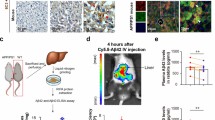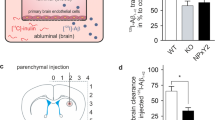Abstract
This article puts forward the hypothesis that the Low Density Lipid Receptor (LDLR) is one of the molecules that is involved in the clearance of amyloid proteins in the brain and that it may play a role in Alzheimer’s Disease (AD) via its up-regulation by statins. The hypothesis is built on the following observations: a-statins (which have been shown to increase LDLR in astrocytes, see below) have a beneficial role in AD, b-defects in the LDL receptor gene are found in AD, c-molecules with similar structure to the LDLR have been shown to clear amyloid protein from the brain.
Similar content being viewed by others
References
Kang J, Lemaire H-G, Unterbeck A, Salbaum JM, Masters CL, Grzeschik K-H, Multhaup G, Beyreuther K, Muller-Hill B (1987) The precursor of Alzheimer’s disease amyloid A4 protein resembles a cell-surface receptor. Nature 325:733–736
Yoshikai S, Sasaki H, Doh-ura K, Furuya H, Sakaki Y (1990) Genomic organization of the human amyloid beta-protein precursor gene. Gene 87:257–263
Kitaguchi N, Takahashi Y, Tokushima Y, Shiojiri S, Ito H (1988) Novel precursor of Alzheimer’s disease amyloid protein shows protease inhibitory activity. Nature 331, 530–532;doi:10.1038/331530a0
Tanzi RE, McClatchey AI, Lamperti ED, Villa-Komaroff L, Gusella JF, Neve RL (1988) Protease inhibitor domain encoded by an amyloid protein precursor mRNA associated with Alzheimer’s disease. Nature 331:528–532
de Sauvage F, Octave JN (1989) A novel mRNA of the A4 amyloid precursor gene coding for a possibly secreted protein. Science Aug 11, 245(4918):651–653
Oltersdorf T, Ward PJ, Henriksson T, Beattie EC, Neve R, Lieberburg I, Fritz LC (1990) The Alzheimer amyloid precursor protein. Identification of a stable intermediate in the biosynthetic/degradative pathway. J Biol Chem 265: 4492–4497
Sinha S, Dovey HF, Seubert P, Ward PJ, Balcher RW, Blaber M, Bradshaw RA, Arici M, Mobley WC, Lieberburg I (1990) The protease inhibitory properties of the Alzheimer’s beta-amyloid precursor protein. J Biol Chem 265: 8983–8985
Konig G, Monning U, Czech C, Prior R, Banati R, Schreiter-Gasser U, Bauer J, Masters CL, Beyreuther K (1992) Identification and differential expression of a novel alternative splice isoform of the beta A4 amyloid precursor protein (APP) mRNA in leukocytes and brain microglial cells. J Biol Chem 267(15):10804–10809.
Estus S, Golde TE, Kunishita T, Blades D, Lowery D, Eisen M, Usiak M, Qu XM, Tabira T, Greenberg BD, (1992a) Potentially amyloidogenic, carboxyl-terminal derivatives of the amyloid protein precursor. Science 255(5045):726–728
Estus S, Golde TE, Younkin SG (1992b) Normal processing of the Alzheimer’s disease amyloid beta protein precursor generates potentially amyloidogenic carboxyl-terminal derivatives. Ann N Y Acad Sci Dec 31 674:138–148
Golde TE, Estus S, Younkin LH, Selkoe DJ, Younkin SG (1992) Processing of the amyloid protein precursor to potentially amyloidogenic derivatives. Science 255(5045):728–730
Seubert P, Vigo-Pelfrey C, Esch F, Lee M, Dovey H, Davis D, Sinha S, Schiossmacher M, Whaley J, Swindlehurst C, McCormack R, Wolfert R, Selkoe D, Lieberburg L & Schenk D (1992) Isolation and quantification of soluble Alzheimer’s beta-peptide from biological fluids. Nature 359, 325–327; doi:10.1038/359325a0
Glenner GG, Wong CW (1984) Alzheimer’s disease: initial report of the purification and characterization of a novel cerebrovascular amyloid protein. Biochem Biophys Res Commun 120(3):885–890
Checler F (1995) Processing of the beta-amyloid precursor protein and its regulation in Alzheimer’s disease. J Neurochem 65: 1431–1444
Mudher A, Lovestone S (2002) Alzheimer’s disease – do tauists and baptists finally shake hands? Trends Neurosci 25(1):22–26
Selkoe DJ (1994) Alzheimer’s disease: a central role for amyloid. J Neuropathol Exp Neurol 53(5):438–447
Uwe B, Stolt P, Herz J (2004) Functions of lipoprotein receptors in neurons. J Lipid Res 45:403–409
Tolleshaug H, Goldstein JL, Schneider WJ, Brown MS (1982) Posttranslational processing of the LDL receptor and its genetic disruption in familial hypercholesterolemia. Cell 30(3):715–724
Brown MS, Goldstein JL (1979) Receptor-mediated endocytosis: insights from the lipoprotein receptor system. Proc Natl Acad Sci USA 76(7):3330–3337
Endo A, Kuroda M (1976) Citrinin, an inhibitor of cholesterol synthesis. J Antibiot (Tokyo) 29(8):841–843
Pavlov OV, Bobryshev YuV, Balabanov YuV, Ashwell K (1995) An in vitro study of the effects of lovastatin on human fetal brain cells. Neurotoxicol Teratol 17(1):31–39
Wolozin B, Kellman W, Ruosseau P, Celesia GG, Siegel G (2000) Decreased prevalence of Alzheimer disease associated with 3-hydroxy-3-methylglutaryl coenzyme A reductase inhibitors. Arch Neurol 57: 1439–1443
Jick H, Zornberg GL, Jick SS, Seshadri S, Drachman DA (2000) Statins and the risk of dementia. Lancet 356: 1627–1631
Hajjar I, Schumpert J, Hirth V,Wieland D, Eleazer GP (2002) The impact of the use of statins on the prevalence of dementia and the progression of cognitive impairment. J Gerontol A Biol Sci Med Sci 57: M414–M418
Rockwood K, Kirkland S, Hogan DB, MacKnight C, Merry H, Verreault R, Wolfson C, McDowell I (2002) Use of lipid-lowering agents, indication bias, and the risk of dementia in community-dwelling elderly people. Arch Neurol 59: 223–227
Zamrini E, McGwin G, Roseman JM (2004) Association between statin use and Alzheimer’s disease. Neuroepidemiology 23: 94–98
Masse I, Bordet R, Deplanque D, Al Khedr A, Richard F, Libersa C, Pasquier F (2005) Lipid lowering agents are associated with a slower cognitive decline in Alzheimer’s disease. J Neurol Neurosurg Psychiatry 76(12):1624–1629
Simons M, Schwarzler F, Lutjohann D, von Bergmann K, Beyreuther K, Dichgans J, Wormstall H, Hartmann T, Schulz JB (2002) Treatment with simvastatin in normocholesterolemic patients with Alzheimer’s disease: a 26-week randomised, placebo-controlled, double-blind trial. Ann Neurol 52: 346–350
Hoglund K, Wiklund O, Vanderstichele H, Eikenberg O, Vanmechelen E, Blennow K (2004) Plasma levels of beta-amyloid (1–40), beta-amyloid (1–42), and total beta-amyloid remain unaffected in adult patients with hypercholesterolaemia after treatment with statins. Arch Neurol 61: 333–337
Breitner JCS, Zandi PP, Li G, Rea TG, Psaty BM (2004) Can statins prevent AD, or are they just prescribed less often to those with cognitive disorders?. Neurobiol Aging 25[S2]: 5
Shepherd J, Blauw GJ, Murphy MB, Bollen EL, Buckley BM, Cobbe SM, Ford I, Gaw A, Hyland M, Jukema JW, Kamper AM, Macfarlane PW, Meinders AE, Norrie J, Packard CJ, Perry IJ, Stott DJ, Sweeney BJ, Twomey C, Westendorp RG (2002) Pravastatin in elderly individuals at risk of vascular disease (PROSPER): a randomised controlled trial. Lancet 360(9346):1623–1630
Wolozin B, Brown J 3rd, Theisler C, Silberman S (2004) The cellular biochemistry of cholesterol and statins: insights into the pathophysiology and therapy of Alzheimer’s disease. CNS Drug Rev 10(2):127–146
Zandi PP, Sparks DL, Khachaturian AS, Tschanz J, Norton M, Steinberg M, Welsh-Bohmer KA, Breitner JC Cache County Study investigators (2005). Do statins reduce risk of incident dementia and Alzheimer disease? The Cache County Study Arch Gen Psychiatry 62(2):217–224
Park IH, Hwang EM, Hong HS, Boo JH, Oh SS, Lee J, Jung MW, Bang OY, Kim SU, Mook-Jung I (2003) Lovastatin enhances Abeta production and senile plaque deposition in female Tg2576 mice. Neurobiol Aging 24:637–643
Retz W, Thome J, Durany N, Harsanyi A, Retz-Junginger P, Kornhuber J, Riederer P, Rosler M (2001) Potential genetic markers of sporadic Alzheimer’s dementia. Psychiatr Genet 11(3):115–122
Luedecking-Zimmer E, DeKosky ST, Chen Q, Barmada MM, Kamboh MI (2002) Investigation of oxidized LDL-receptor 1 (OLR1) as the candidate gene for Alzheimer’s disease on chromosome 12. Hum Genet 111(4–5):443–451
D’IntronoA, Solfrizzi V, Colacicco AM, Capurso C, Torres F, Capurso SA, Capurso A, Panza F (2005) Polymorphisms in the oxidized low-density lipoprotein receptor-1 gene and risk of Alzheimer’s disease. J Gerontol A Biol Sci Med Sci. 60(3):280–284
Gopalraj RK, Zhu H, Kelly JF, Mendiondo M, Pulliam JF, Bennett DA, Estus S (2005) Genetic association of low density lipoprotein receptor and Alzheimer’s disease. Neurobiol Aging 26(1):1–7
Bertram L, Parkinson M, Mullin K, Menon R, Blacker D, Tanzi RE (2004) No association between a previously reported OLR1 3’ UTR polymorphism and Alzheimer’s disease in a large family sample. J Med Genet 41(4):286–288
Papassotiropoulos A, Wollmer MA, Tsolaki M, Brunner F, Molyva D, Lutjohann D, Nitsch RM, Hock C (2005) A cluster of cholesterol-related genes confers susceptibility for Alzheimer’s disease. J Clin Psychiatry 66(7):940–947
Shi J, Tian J, Pritchard A, Lendon C, Lambert JC, Iwatsubo T, Mann DM (2006) A 3′-UTR polymorphism in the oxidized LDL receptor 1 gene increases Abeta(40) load as cerebral amyloid angiopathy in Alzheimer’s disease. Acta Neuropathol (Berl) 111(1):15–20
Cao D, Fukuchi KI, Wan H, Kim H, Li L (2005) Lack of LDL receptor aggravates learning deficits and amyloid deposits in Alzheimer transgenic mice. Neurobiol Aging
Yang DS, Small DH, Seydel U, Smith JD, Hallmayer J, Gandy SE, Martins RN (1999) Apolipoprotein E promotes the binding and uptake of beta-amyloid into Chinese hamster ovary cells in an isoform-specific manner. Neuroscience 90(4):1217–1226
Qiu Z, Strickland DK, Hyman BT, Rebeck GW (1999) Alpha2-macroglobulin enhances the clearance of endogenous soluble beta-amyloid peptide via low-density lipoprotein receptor-related protein in cortical neurons. J Neurochem 73(4):1393–1398
Kang DE, Pietrzik CU, Baum L, Chevallier N, Merriam DE, Kounnas MZ, Wagner SL, Troncoso JC, Kawas CH, Katzman R, Koo EH (2000) Modulation of amyloid beta-protein clearance and Alzheimer’s disease susceptibility by the LDL receptor-related protein pathway. J Clin Invest 106(9):1159–1166
Deane R, Wu Z, Zlokovic B (2004a) Beta-peptide clearance through transport across the blood–brain barrier RAGE (Yin) versus LRP (Yang) balance regulates. Alzheimer Amyloid Stroke 35:2628–2631
Deane R, Wu Z, Sagare A, Davis J, Du Yan S, Hamm K, Xu F, Parisi M, LaRue B, Hu HW, Spijkers P, Guo H, Song X, Lenting PJ, Van Nostrand WE, Zlokovic BV (2004b) LRP/amyloid beta-peptide interaction mediates differential brain efflux of Abeta isoforms. Neuron Aug 5, 43(3):333–344
Shibata M, Yamada S, Kumar SR, Calero M, Bading J, Frangione B, Holtzman DM, Miller CA, Strickland DK, Ghiso J, Zlokovic BV (2000) Clearance of Alzheimer’s amyloid-ss(1–40) peptide from brain by LDL receptor-related protein-1 at the blood–brain barrier. J Clin Invest 106:1489–1499
Rebeck GW, Reiter JS, Strickland DK, Hyman BT (1993) Apolipoprotein E in sporadic Alzheimer's disease: allelic variation and receptor interactions. Neuron 11(4):575–580
Kounnas MZ, Moir RD, Rebeck GW, Bush AI, Argraves WS, Tanzi RE, Hyman BT, Strickland DK (1995) LDL receptor related protein, a multifunctional ApoE receptor, binds secreted beta-amyloid precursor protein and mediates its degradation. Cell 82(2):331–340
Van Uden E, Mallory M, Veinbergs I, Alford M, Rockenstein E, Masliah E (2002) Increased extracellular amyloid deposition and neurodegeneration in human amyloid precursor protein transgenic mice deficient in receptor-associated protein. J Neurosci 122(21):9298–9304
Zerbinatti and Bu (2005) LRP and Alzheimer’s disease Rev Neurosci. 16(2):123–135. Review
Harris-White, Frautschy (2005) Low density lipoprotein receptor-related proteins (LRPs), Alzheimer’s and cognition Curr Drug Targets. CNS Neurol Disord 4(5):469–480
Kim S, Kim CH, Vaziri ND (2005) Upregulation of hepatic LDL receptor-related protein in nephrotic syndrome: response to statin therapy. Am J Physiol Endocrinol Metab 288(4):E813–817
Suzuki H, Yamazaki H, Aoki T, Kojima J, Tamaki T, Sato F, Kitahara M, Saito Y (2000) Lipid-lowering and antiatherosclerotic effect of NK-104, a potent 3-hydroxy-3-methylglutaryl coenzyme A reductase inhibitor, in Watanabe heritable hyperlipidemic rabbits. Arzneimittelforschung 50(11):995–1003
Zlokovic B (2005) Neurovascular Mechanisms of Alzheimer’s neurodegeneration. Trends Neurosci 28(4):202–208
Wu Z, Guo H, Chow N, Sallstrom J, Bell RD, Deane R, Brooks AI, Kanagala S, Rubio A, Sagare A, Liu D, Li F, Armstrong D, Gasiewicz T, Zidovetzki R, Song X, Hofman F, Zlokovic BV (2005) Role of the MEOX2 homeobox gene in neurovascular dysfunction in Alzheimer disease. Nat Med 11(9):959–965
Author information
Authors and Affiliations
Corresponding author
Rights and permissions
About this article
Cite this article
Abdulkarim, Y., Hameed, Z. Is the LDL Receptor Involved in Cortical Amyloid Protein Clearance?. Neurochem Res 31, 839–847 (2006). https://doi.org/10.1007/s11064-006-9084-0
Accepted:
Published:
Issue Date:
DOI: https://doi.org/10.1007/s11064-006-9084-0




